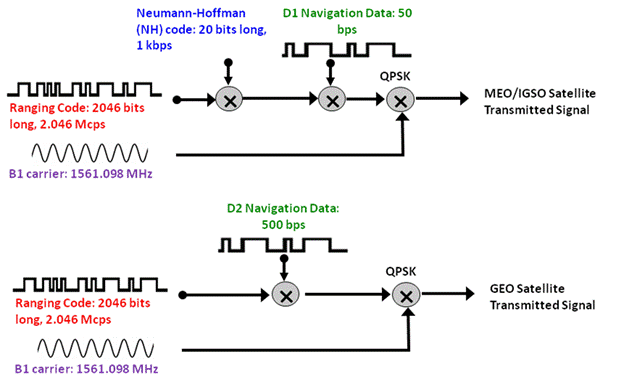
The official name of the Chinese GNSS is Beidou Navigation Satellite System, also called the Beidou System (BDS) for short. Previously the system was also known as Beidou-2, to distinguish it from the earlier experimental Beidou-1 system. The name Compass was also used, taken from the names of the satellites.
Unlike the other GNSS systems that only have medium earth orbit (MEO) satellites, Beidou will also include five geostationary earth orbit (GEO) satellites and three satellites with inclined geosynchronous orbit (IGSO). Sixteen satellites have been launched as of March 2013. The Beidou system began offering regional service covering the Asia Pacific area in December 2012, and completion of the full system is planned for 2020.
The system specifications in the Interface Control Document that was released in December 2012, covers the open service signal B1I, which is transmitted at a frequency of 1561.098 MHz. Other frequencies allocated for Beidou include the B2 and B3 bands, which overlap with the E5 and E6 bands for Galileo. The definitions for those signals have not been publicly released. Signal Studio supports simulation of the Beidou B1I signal.
Like GPS and Galileo, Beidou is a CDMA system with a different ranging code for each satellite. The signals transmitted by the MEO and IGSO satellites are different from the signals transmitted by the GEO satellites.
The Beidou signal has the following components as shown in the figure:
For the MEO and IGSO satellites, the ranging code is 2046 bits long and transmitted at a rate of 2.046 Mchips per second. The ranging code is multiplied by a secondary code called the Neumann-Hoffman code, which is a fixed 20-bit sequence at a data rate of 1 kbps. This data is combined with the D1 navigation message and transmitted at 50 bps. The resulting stream is modulated onto the B1 carrier, a sine wave at 1561.098 MHz using QPSK modulation. But since the ICD is defining only the I (real) component of the signal, the modulation appears to be BPSK.
For the GEO satellites, the secondary code is not used, and a different navigation message is transmitted. The ranging code is combined with the D2 navigation message data transmitted at a faster rate of 500 bps, and the combined data is modulated with QPSK onto the B1 carrier.
Construction of Beidou B1I transmitted signals

The D1 navigation message that is broadcasted by the MEO and IGSO satellites contains 36,000 bits of data organized in 24 pages or frames. For the broadcasting satellite, it includes the basic navigation information that includes the time, clock correction data, health status, ephemeris, and ionosphere model parameters, as well as the almanac for all of the satellites. The D2 navigation message that is broadcasted by the GEO satellites is much longer, consisting of 180,000 bits of data organized into 120 frames or pages. In addition to the data contained in the D1 navigation message, the D2 message also includes system integrity and differential correction information that can be used to improve the accuracy of the receiver’s location calculations.